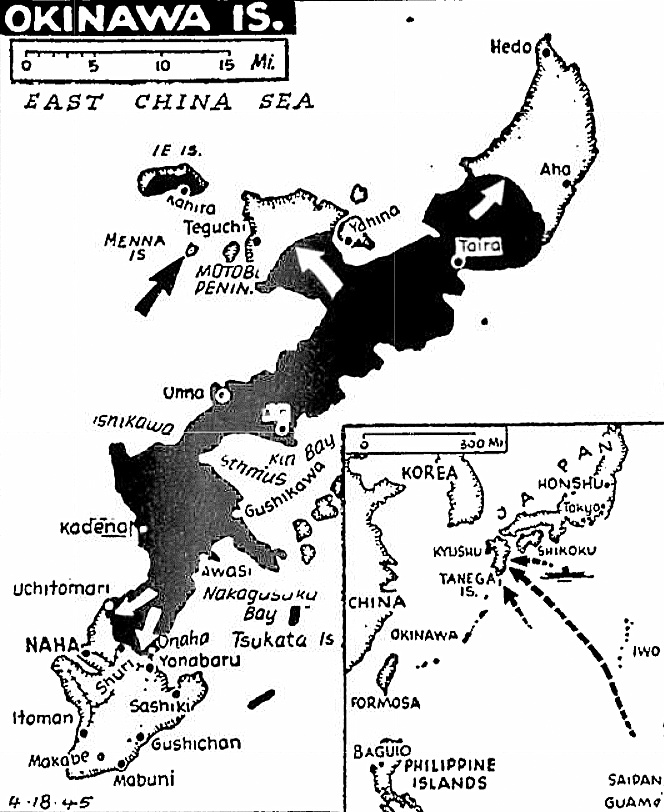Superfortresses hammer Japan twice within 12 hours
B-29s aim of airports housing planes used in suicide attacks against Yanks off Okinawa

Reported new landing by U.S. troops was on Minna Island, off Okinawa’s Motobu Peninsula. Nearby Ie Island was virtually occupied. The Japs continued to fight hard on Motobu Peninsula. To the northeast of Okinawa (inset map), U.S. Superfortresses blasted Jap airfields on Kyushu Island twice in 12 hours, and U.S. carrier planes joined in the attacks. In the Philippines, U.S. forces stormed Baguio.
GUAM (UP) – More than 100 Superfortresses ripped Japan’s six main suicide-plane bases in Southern Kyushu before dawn today for the second time in less than 12 hours.
The Superfortresses’ fastest one-two punch yet against Japan was designed to knock out airfields from which enemy suicide pilots have been taking off to crash their explosive-laden planes against U.S. warships off Okinawa.
Today’s raid marked the third anniversary of Lt. Gen. James H. Doolittle’s historic carrier-based raid on Tokyo, now nearly one-tenth destroyed as result of B-29 fire raids in the past six weeks.
Report new landing
A Jap broadcast said U.S. troops have landed on tiny Minna Island, just south of nearly-conquered Ie Island and three miles off Okinawa’s embattled Motobu Peninsula.
The invasion, like that of Ie, was designed to gain additional airfields for the Americans, the broadcast said. It indicated the landing occurred simultaneously with that on Ie Monday.
Pacific Fleet headquarters was silent on the purported landing but announced that two-thirds of Ie had already been cleared against moderate resistance.
Marines win hill
On Okinawa, Marines battled 1,200 to 2,200 Japs entrenched in the hills of Motobu Peninsula in the northern sector. The Japs counterattacked four times yesterday and an important hill changed hands twice in the vicious fighting. Three hundred enemy dead were found when the Marines finally won a firm hold on the hill.
The XXIV Army Corps front above Naha, the capital of Okinawa, was quiet.
Superfortresses which roared out from the Marianas to bomb Kyushu, Japan’s southernmost home island, early today passed in flight some of the last squadrons homeward bound from yesterday’s afternoon raid.
Both forces sowed their explosives on Tachiarai, Kanoya, East Kanoya, Izumi, Kokumbu and Nittaghara airfields.
2,813 planes blasted
The raids were believed to have added materially to the toll of 2,813 Jap planes destroyed or damaged over and on Southern Japan and the Ryukyu Island chain since March 17.
A Pacific Fleet communiqué said U.S. air forces alone had destroyed 2,200 enemy aircraft in the period. British carrier planes accounted for an additional 80 and B-29s destroyed 105 more. Another 428 were damaged.
A XXI Bomber Command announcement said B-29s which hit Japan early Monday burned out an additional 5.2 square miles in Tokyo and 2.9 square miles in the nearby industrial center of Kawasaki.
